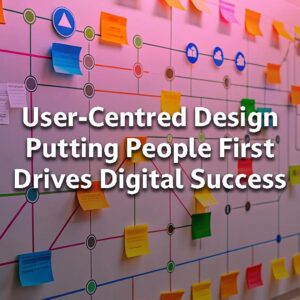Understanding the Basics of UI/UX Design

Understanding the Basics of UI/UX Design right now in the digital age we live in is critical. As a result, the success of a businesses often hinges on its online presence. A key factor in this success is the design of its digital platforms.
Enter UI/UX design.
UI, or User Interface, focuses on the look and layout of a product. In other words, it’s about aesthetics and visual communication. It’s what users see and interact with on a screen.
UX, or User Experience, on the other hand, is about the overall feel of a product. It’s about functionality and usability. It’s how users interact with a product and how it makes them feel.
Together, UI and UX create a cohesive user experience. They are two sides of the same coin, each as a result playing a crucial role in how users perceive and interact with a product.
But why does Understanding UX UI Design matter?
Well my friend, it matters because good UI/UX design enhances everything! And that includes user satisfaction and in turn, even loyalty. It makes digital platforms more intuitive, more engaging, and more effective. It can be the difference between a user staying on your website or app, or leaving for a competitor’s.
UI/UX design also has the ability to directly impact your bottom line. It can boost conversion rates, drive business growth, and build authority and trust.
In this article, we’ll delve into the basics of UI/UX design. Furthermore, we’ll explore its importance in the digital economy, its process, and its business impact.
We’ll also discuss the concept of growth-driven design. This is a strategy for continuous improvement, using data and analytics to refine and enhance UI/UX design.
Finally, we’ll touch on how to choose the right UI/UX design services company, and look at future trends and innovations in the field.
Whether you’re a marketing manager, a startup founder, or a CEO, this article will provide valuable insights into the world of UI/UX design. And why It’s time to embrace UI/UX design for the digital success of your business!
The Importance of UI/UX Design in the Digital Economy
In today’s digital economy, understanding UI/UX design is more important than ever. An engaging digital presence can set a business apart and provide a competitive edge in crowded markets.
UI/UX design can not only influence how users perceive a brand, It can make interactions seamless and enjoyable and as a result earn its own keep. Like the 24/7 employee you never new you needed. That;s right, a welcoming customer service rep, around the clock. One with a well-designed interface that also encourages users to stay longer and come back! And what business doesn’t want satisfied customers?
High-quality UI/UX design can lead to increased conversion rates. A smooth user journey often translates to repeat customers and sales growth.
Moreover, UI/UX design is integral to brand identity. It builds trust and loyalty. Investing in UI/UX is investing in a business’s reputation and future success.
By employing UX/UI design along with other tactics, your website could be your employee of the month, every month!
Defining UI and UX: A Dual Focus on Aesthetics and Functionality
UI and UX are fundamental components of digital design. They work in tandem to create satisfying user experiences. Each focuses on different aspects of design yet they overlap in many ways.
UI design revolves around aesthetics. It is about crafting visually appealing easy to navigate interfaces. Good UI ensures intuitive navigation and pleasing visuals.
UX design, however, delves into the overall experience. It’s about functionality and user interactions. UX aims to make a product user-friendly and enjoyable.
Together, UI and UX form an unstoppable two pronged attack, much like Glenn McGrath and Shane Warne did for the Australian cricket team throughout the mid 90’s and 2000’s. both offer different things, but they have the same goal and desire to win. UX & UI shape how users perceive and engage with digital products. This synergy is vital for a successful digital presence.UI (User Interface) Design: More Than Just Looks
UI design is about much more than appearance. It involves crafting a clear and consistent layout. This layout guides users smoothly through an interface.
A successful UI design is intuitive. It involves strategic use of colors, typography, and spacing. These elements create a sense of hierarchy and focus.
Beyond aesthetics, UI design enhances usability.
It ensures that users can easily access and use a product’s features. This direct impact on user satisfaction can elevate a brand.UX (User Experience) Design: Crafting the Overall Feel
UX design focuses on crafting a seamless user journey. It’s about understanding user needs and meeting them effectively. The goal is to make interactions as intuitive and enjoyable as possible.
Empathy is central to UX design. Designers anticipate user behaviours and address potential pain points. This approach leads to smoother navigation and more engaging interactions.
Ultimately, UX design is about the feel of the product. It ensures that users leave satisfied and content. This satisfaction is key to fostering loyalty and repeated engagement.
The Interplay Between UI and UX: Creating Harmonious Digital Experiences
The relationship between UI and UX is dynamic. Together, they craft harmonious digital experiences. Each aspect complements the other, creating a balanced design.
UI provides the visual framework. It captures attention and guides navigation. UX ensures functionality and ease of use, making sure the journey is worth the user’s time.
In successful designs, UI and UX are inseparable. Great visuals paired with great experiences lead to memorable interactions. They draw users in and encourage continued engagement.
The interplay of UI and UX also impacts business outcomes. Effective collaboration between the two can enhance brand reputation. It provides a foundation for growth-driven digital strategies.
The UI/UX Design Process: An Iterative Journey
The UI/UX design process is a continuous journey. It’s flexible and responsive, adapting with each iteration. This approach ensures the design meets user and business needs.
At its core, this process is user-centric. Designers start by understanding user behaviours and preferences. They gather insights to guide each design phase effectively.
The process is iterative, involving repeated cycles of evaluation and refinement. Designers craft wireframes and prototypes, bringing ideas to life. Feedback from users and stakeholders shapes the next steps.
Designers use a structured approach, which often includes the following stages:
- Conduct user research and create personas.
- Design wireframes and prototypes.
- Perform usability testing.
- Gather and analyze feedback.
- Refine the design based on insights.
Iterative cycles of testing and feedback are crucial. They uncover usability issues and potential improvements. This ongoing process promotes continuous enhancement of the user experience.
Understanding Your Audience: The Role of User Research and Personas
Understanding the audience is crucial in UI/UX design. Effective design starts with thorough user research. This step uncovers user needs, preferences, and pain points.
Through interviews and surveys, designers gather valuable insights. Observing actual user interactions provides real-world data. This empirical approach ensures a deeper understanding of user behavior.
Personas play a pivotal role in this process. They represent typical users, complete with characteristics and goals. Designers use personas to tailor the design to meet specific needs.
By empathizing with the user, designers create more intuitive experiences. This user-centric approach is key to crafting interfaces that resonate. It ensures the final product truly aligns with user expectations.
From Wireframes to Prototypes: Visualising the User Interface
Wireframes and prototypes are essential tools in UI/UX design. Wireframes provide a skeleton view of the interface. They outline structure and layout without focusing on detailed aesthetics.
These tools help visualize the user interface early in the process. Wireframes guide the placement of elements like buttons and menus. They allow designers to plan navigation and interaction paths.
Prototypes are more detailed and interactive than wireframes. They simulate how the final product will function. Prototyping enables designers to test flows and refine functionalities.
By visualizing ideas early, designers reduce risks. They identify usability issues before investing in full development. This proactive approach saves time and resources while enhancing design quality.
Usability Testing and Feedback: Refining the User Experience
Usability testing is a vital step in refining UI/UX design. It involves real users interacting with the product. In addition, that means observing their behaviour reveals design strengths and weaknesses.
Feedback from usability testing drives improvements. Firstly, it highlights areas where users struggle and secondly where they may disengage. Using heat maps and other tools, our Designers use this feedback to refine features and enhance the experience.
Continuous feedback loops are integral to the iterative process. They enable designers to adapt and evolve the design. This adaptability ensures the final product meets user expectations.
Incorporating usability testing throughout development is beneficial. It helps align the design with real-world usage and user behaviour. A refined user experience is proven to result in higher satisfaction and loyalty.
The Business Impact of UI/UX Design
UI/UX design significantly impacts business outcomes. Its influence extends beyond aesthetics to tangible business metrics. Proper design can transform user interactions into valuable engagements.
Effective UI/UX design enhances user satisfaction. When users find a product easy and pleasing to use, loyalty increases. This, in turn, translates to repeated business and positive word-of-mouth recommendations.
The design can also drive conversion rates higher. By streamlining the user journey, it reduces obstacles to desired actions. This seamless experience encourages users to complete transactions or subscribe.
Moreover, a well-crafted UI/UX builds a strong brand identity. It reflects the company’s values and fosters trust among users. Consistent branding through design helps users feel more connected to the brand.
Ultimately, UI/UX design aligns with strategic business goals. It supports a company’s growth by engaging users effectively. In the fast-paced digital economy, investing in UI/UX design is crucial for sustained success.
Enhancing User Satisfaction and Loyalty Through Design
User satisfaction is paramount in today’s competitive market. UI/UX design plays a crucial role in achieving this goal. When users have positive interactions, satisfaction naturally follows.
A seamless, intuitive interface creates a pleasant user experience. Users appreciate designs that address their needs effortlessly. This satisfaction can lead to heightened user loyalty over time.
Consistency across touchpoints further strengthens loyalty. When users encounter familiar patterns, they feel more secure. This reliability builds trust, encouraging users to return.
Ultimately, loyalty is tied to the quality of design. Satisfied users are likely to advocate for the brand. Thus, a focus on UI/UX design enhances both satisfaction and loyalty.
UI/UX Design as a Driver for Conversion Rates and Business Growth
Effective UI/UX design is a powerful driver of conversion rates. It streamlines processes, guiding users toward desired actions. By reducing friction, it enhances the likelihood of conversion.
Clear calls-to-action and logical navigation are crucial elements. They direct users through the digital journey seamlessly. A user-friendly interface effectively converts interest into action.
Improved conversions contribute directly to business growth. As sales or sign-ups increase, revenue follows suit. Thus, UI/UX design can have a profound impact on a company’s bottom line.
By continuously refining UI/UX, businesses can optimize growth potential. Tracking user behavior informs necessary adjustments. This data-driven approach ensures sustained business success.
Building Brand Identity and Trust with UI/UX
UI/UX design plays a vital role in building brand identity. A distinctive design conveys the essence of a brand. Users associate well-crafted interfaces with professionalism and reliability.
Consistency is key in this process. Cohesive design across platforms strengthens brand recognition. Users develop trust when they experience uniformity in interactions.
Moreover, UI/UX design communicates brand values subtly. Each design choice reflects the company’s ethos and culture. This deeper connection fosters a sense of trust and loyalty.
Trust leads to long-lasting relationships between users and brands. A strong UI/UX design can serve as a foundation for trust. It helps establish a compelling brand image in users’ minds.
Growth-Driven Design: A Strategy for Continuous Improvement
Growth-driven design is a dynamic methodology. It focuses on continuous optimisation rather than static completion. This approach ensures that digital platforms evolve in line with user needs.
Unlike traditional designs, it prioritises adaptability. Changes in the digital landscape demand flexible strategies. This method allows businesses to respond effectively to user feedback and trends.
By embracing growth-driven design, companies can reduce risks. Incremental updates lower the chances of extensive failures. This proactive approach enhances the reliability of digital solutions.
Continuous improvement is a core component of this strategy. It emphasizes ongoing learning and iteration. Regularly analyzing user interactions leads to informed design decisions.
Ultimately, growth-driven design promotes sustained progress. It aligns digital offerings with user expectations. This strategy helps maintain a competitive edge in the digital economy.
The Role of Data and Analytics in UI/UX Design Decisions
Data and analytics are invaluable assets in UI/UX design. They provide insights into user behaviors and preferences. Armed with this information, designers can make evidence-based decisions.
Analytics reveal how users interact with digital platforms. They uncover patterns that highlight areas for improvement. This data-driven approach enhances decision-making precision.
Designers can test variations and measure outcomes effectively. A/B testing and heatmaps are tools that guide refinements. These insights lead to more user-centered solutions.
Ultimately, data empowers designers to optimise UI/UX continually. It fuels a cycle of analysis, testing, and enhancement. This informed approach results in designs that truly resonate with users.
Aligning UI/UX Design with Business Objectives for Long-Term Success
Understanding that aligning UI/UX design with business goals is also crucial. It ensures that digital strategies support broader company ambitions. This synergy strengthens the impact of both design and business efforts.
To achieve alignment, communication between teams is vital. Designers, developers, and stakeholders must collaborate. Clear objectives guide the design process, enhancing coherence.
Strategic design choices should reflect business priorities. When design solutions serve functional goals, they maximize value. This focus ensures that UI/UX efforts contribute meaningfully to growth.
Effective alignment requires ongoing assessment and adaptation. As business goals evolve, design strategies should too. This responsiveness maintains relevance in a changing market.
Ultimately, alignment fosters long-term success. Harmonized UI/UX strategies and business objectives lead to sustained growth. They create a foundation for continued achievement in the digital realm.
Choosing the Right UI/UX Design Services Company
Choosing a UI/UX design services company is a critical decision. The right partner can transform your digital presence. It’s essential to look for a company with a proven track record.
Experience in diverse industries is a strong indicator of expertise. This breadth of experience allows for adaptable and innovative approaches. A company that understands your sector can address specific challenges effectively.
Evaluating the firm’s portfolio is crucial. A rich portfolio showcases versatility and creativity. It provides insights into their ability to deliver customized solutions.
Communication is key in any partnership. Ensure the company prioritizes transparent and open dialogue. This practice fosters a collaborative relationship where ideas flow freely.
Ultimately, the choice of a UI/UX design services company impacts your success. The right partner should align with your vision and objectives. Their expertise will drive your digital strategy forward, enhancing user experiences.
The Value of Expert UI/UX Solutions for Your Business Challenges
Expert UI/UX solutions address distinct business challenges effectively. Such expertise allows companies to craft tailored user experiences. This focus leads to increased user engagement and satisfaction.
Professional UI/UX design considers user behavior, aesthetics, and functionality. By prioritizing these aspects, businesses can create intuitive interfaces. These elements collectively enhance overall usability and satisfaction.
Employing skilled professionals results in well-informed design decisions. Their knowledge base informs every choice and customization. This expertise leads to solutions that address unique business needs directly.
The Benefits of a Strategic Partnership with a UI/UX Agency
A strategic partnership with a UI/UX agency offers numerous benefits. Agencies provide access to a wealth of experience and innovation. Their expertise fosters creativity and ensures high-quality design outcomes.
Working with a dedicated agency promotes consistent improvement. They remain updated with industry trends and emerging technologies. This dedication ensures that your digital presence remains competitive.
Moreover, agencies offer a comprehensive approach to design. They integrate research, prototyping, and testing seamlessly. This holistic method provides solutions aligned with your business’s vision and goals.
Agile and Custom UI/UX Solutions for Market Leaders
Agile and custom UI/UX solutions drive innovation for market leaders. Agility allows businesses to adapt swiftly to changes and feedback. This approach ensures that solutions evolve with user needs and market shifts.
Customization leads to personalized and effective user experiences. Tailored designs resonate with target audiences, enhancing satisfaction. A customized approach addresses specific challenges and fosters engagement.
For market leaders, these solutions offer a competitive edge. They facilitate rapid iterations and improvements, keeping businesses ahead. Embracing agile and custom design solutions ensures sustained success in dynamic markets.
Future Trends and Innovations in UI/UX Design
The UI/UX design landscape is constantly evolving. Innovations are driving new possibilities for user experiences. Designers must stay ahead of these trends to remain competitive.
One significant trend is the integration of artificial intelligence. AI offers personalization and intuitive interactions, transforming user interfaces. Machine learning refines and adapts these experiences over time.
Additionally, virtual and augmented reality are reshaping how we interact digitally. These technologies create immersive environments, enhancing engagement. As they become more mainstream, their influence on UI/UX will grow.
Another emerging trend is the emphasis on minimalism. Simplified designs lead to streamlined user interactions. They enhance clarity and usability, fostering quicker decision-making.
Finally, the push for accessibility continues to gain momentum. Inclusive design ensures that digital platforms are usable by everyone. This trend reflects a broader commitment to social responsibility in tech.
The Role of AI and Machine Learning in Enhancing UI/UX
AI and machine learning enhance UI/UX by offering smarter solutions. These technologies provide personalised experiences based on user behavior. They adapt interfaces in real-time, improving user satisfaction.
AI-driven chatbots and virtual assistants are increasingly common. They offer instant support and personalized interactions. These tools streamline processes and enhance customer service.
Moreover, machine learning enables data-driven design decisions. By analyzing user data, designers can refine interfaces. This approach leads to improved usability and engagement over time.
The Importance of a Mobile-First Approach and Responsive Design
Mobile-first design is crucial in today’s digital world. With more users accessing the web via mobile devices, it’s essential. Designing for mobile ensures accessibility and a seamless experience.
Responsive design complements mobile-first strategies effectively. It allows interfaces to adapt across various devices and screens. This flexibility meets users wherever they are, enhancing satisfaction.
Prioritizing mobile and responsive design prepares businesses for the future. It ensures that user experiences remain consistent and efficient. As mobile usage continues to grow, this focus becomes indispensable.
Ethical Design and User Privacy: The New Frontiers of UI/UX
Ethical design and user privacy are critical in UI/UX today. As users become more privacy-conscious, respecting their data is vital. Ethical design principles build trust and loyalty by prioritizing user rights.
Incorporating privacy by design ensures that data protection is embedded. This practice leads to transparent and secure user interactions. Users feel safer knowing that their data is handled responsibly.
Designers must also address accessibility and inclusivity. Ethical design includes all users, regardless of ability. This commitment results in equitable and user-friendly digital experiences.
Conclusion: Embracing UI/UX Design for Digital Success
In the digital era, UI/UX design is indispensable. It bridges the gap between technology and user needs. An effective design can revolutionize how businesses engage with their audiences.
Crafting impactful UI/UX requires understanding the need for a strategic approach. Emphasizing aesthetics and functionality cultivates user satisfaction. This focus on user-centered design fosters loyalty and trust.
Moreover, integrating growth-driven strategies ensures continuous improvement. By leveraging data and feedback, businesses can refine their platforms. This iterative process not only enhances user experience but also drives measurable growth.
Embracing UI/UX design translates to staying competitive. Businesses willing to innovate with cutting-edge design practices will thrive. In doing so, they can maximize digital potential and secure long-term success.








